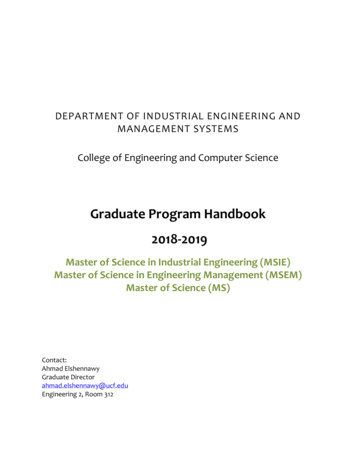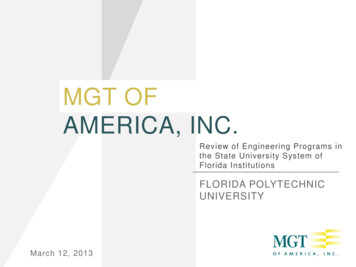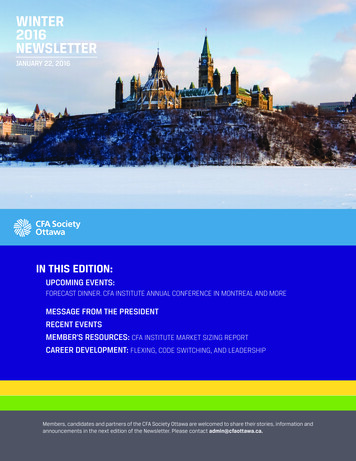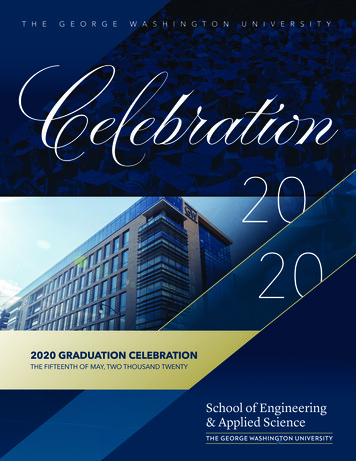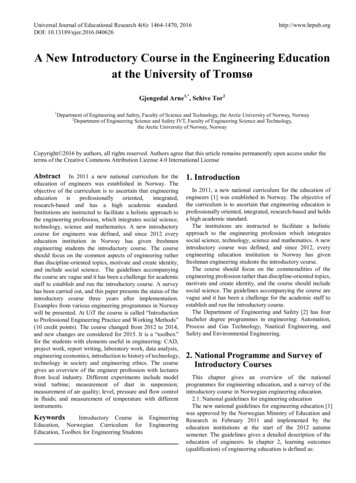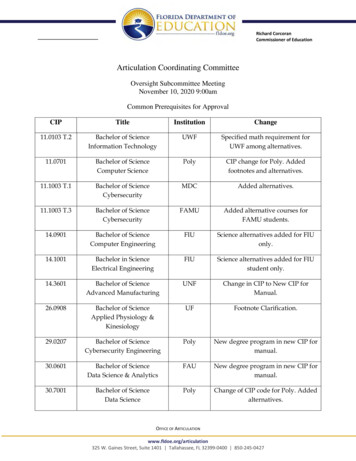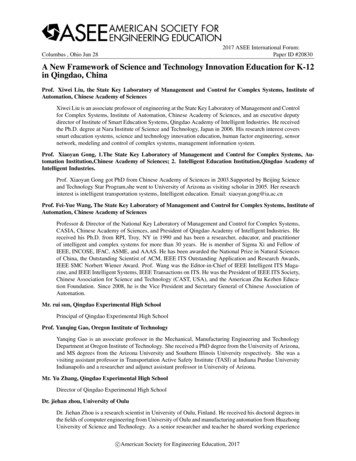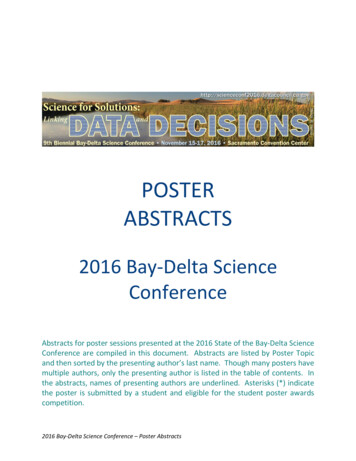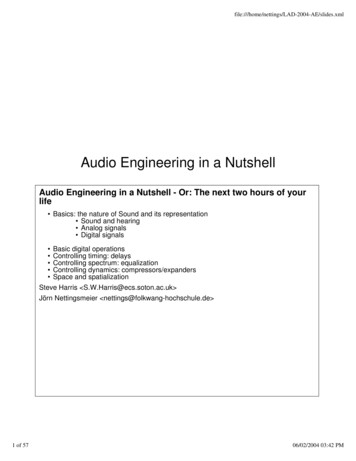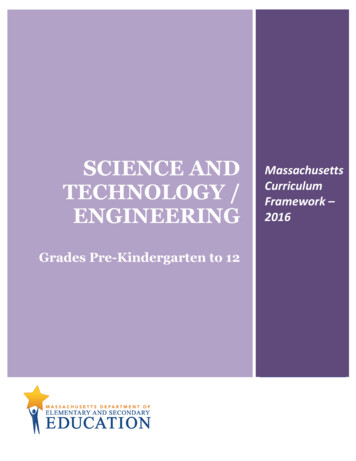
Transcription
SCIENCE ANDTECHNOLOGY /ENGINEERINGGrades Pre-Kindergarten to 12MassachusettsCurriculumFramework –2016
This document was prepared by the Massachusetts Department of Elementary and Secondary EducationBoard of Elementary and Secondary Education MembersMr. Paul Sagan, Chair, CambridgeMr. James Morton, Vice Chair, BostonMs. Katherine Craven, BrooklineDr. Edward Doherty, Hyde ParkMs. Amanda Fernandez, BelmontMs. Margaret McKenna, BostonMr. Michael Moriarty, HolyokeMr. James Peyser, Secretary of Education, MiltonMs. Mary Ann Stewart, LexingtonDr. Martin West, NewtonMs. Hannah Trimarchi, Chair, Student AdvisoryCouncil, MarbleheadMitchell D. Chester, Ed.D., Commissioner and Secretary to the BoardThe Massachusetts Department of Elementary and Secondary Education, an affirmative action employer, iscommitted to ensuring that all of its programs and facilities are accessible to all members of the public. We donot discriminate on the basis of age, color, disability, national origin, race, religion, sex, or sexual orientation.Inquiries regarding the Department’s compliance with Title IX and other civil rights laws may be directed tothe Human Resources Director, 75 Pleasant St., Malden, MA, 02148, 781-338-6105. 2019 Massachusetts Department of Elementary and Secondary Education.Permission is hereby granted to copy any or all parts of this document for non-commercial educationalpurposes. Please credit the “Massachusetts Department of Elementary and Secondary Education.”Massachusetts Department of Elementary and Secondary Education75 Pleasant Street, Malden, MA 02148-4906Phone 781-338-3000 TTY: N.E.T. Relay 800-439-2370www.doe.mass.edu
Massachusetts Department ofElementary and Secondary Education75 Pleasant Street, Malden, Massachusetts 02148-4906Dear Colleagues:I am pleased to present to you the 2016 Massachusetts Science and Technology/Engineering (STE) CurriculumFramework. This Framework articulates statewide guidelines for STE learning, teaching, and assessment for theCommonwealth’s public schools.To prepare students for success in college, career, and civic life, the 2016 STE standards emphasize the need forstudent engagement, relevance, rigor, and coherence in curriculum and instruction. The standards: Focus on conceptual understanding and application of concepts. Integrate disciplinary core ideas and practices to reflect the discipline of science. Present coherent progressions of STE core ideas and practices from pre-K to high school. Include each discipline in grade-level standards pre-K to grade 8. Contribute to preparation for post-secondary success in college and careers. Coordinate with the English Language Arts (ELA) and Mathematics standards.The 2016 STE standards maintain much of the content of our prior STE standards with updates to reflect changesidentified by the field, changes in science and engineering over the past 15 years, and the addition of inquiry anddesign skills that students need to successfully engage in this discipline in pre-K–12 classrooms, civic life, andpost-secondary opportunities. The 2016 STE standards strengthen the often-lauded standards Massachusetts hasrelied on since 1996.I would like to thank all of the individuals and groups that provided input, reviewed comments, and suggestededits to the standards, as well as those who contributed to the sections of the Framework. This effort includedmany representatives from across the state. The Department of Early Education and Care (EEC) and theDepartment of Higher Education (DHE) were key collaborators to ensure a coherent perspective for all students.I am grateful for the dedication and expertise of all the educators, professionals, scholars, and other participantswho engaged with the Department in this endeavor.I believe a strong understanding of science and technology/engineering is critical for every student in theCommonwealth. Every student must understand the world around them and be able to apply analytical andinnovative thinking to complex problems they will face in civic and career contexts. This Framework providesguidance and resources intended to help educators and professionals prepare students for such success. Thankyou for your ongoing support for quality STE education and for your commitment to achievement of suchimportant goals for all students in the Commonwealth.Sincerely,Mitchell D. Chester, Ed.D.Commissioner of Elementary and Secondary Education
Table of ContentsAcknowledgments . 3A Vision of Science and Technology/Engineering Education . 7Science and Technology/Engineering Education for All Students: The Vision . 8Guiding Principles for Effective Science and Technology/Engineering Education . 14Science and Technology/Engineering Learning Standards .23Overview of the Standards . 24Use of Selected Terms . 26Grades Pre-K–2: Overview of Science and Engineering Practices . 27Pre-Kindergarten . 29Kindergarten . 32Grade 1 . 34Grade 2 . 36Grades 3-5: Overview of Science and Engineering Practices . 39Grade 3 . 41Grade 4 . 45Grade 5 .48Grades 6-8: Overview of Science and Engineering Practices . 52Grade 6 . 54Grade 7 .60Grade 8 . 66High School: Overview of Science and Engineering Practices . 72High School Earth and Space Science . 74High School Biology . 78High School Chemistry .84High School Introductory Physics . 89High School Technology/Engineering . 94Massachusetts Curriculum Framework for Science and Technology/Engineering1
Standards-Related Appendices . 97Appendix I: Science and Engineering Practices Progression Matrix . 98Appendix II: Essential Role of Language, Literacy, and Mathematics for Science andTechnology/Engineering Learning for All Students . 125Appendix III: Disciplinary Core Idea Progression Matrix . 131Appendix IV: Strand Maps of Science and Technology/Engineering Standards . 145Curriculum-Related Appendices . 147Appendix V: The Case for an Integrated Approach in Grades Pre-K–8 . 148Appendix VI:Importance of Science and Engineering in Early Education . 152Appendix VII: Science and Technology/Engineering Laboratories . 154Appendix VIII: Value of Crosscutting Concepts and Nature of Science in Curricula . 156Appendix IX: Relevant Contexts for Teaching Science and Technology/Engineering . 169Appendix X: The Value of Out of School Time Programming . 171Appendix XI: Safety Practices and Legal Requirements .173Appendix XII: Dissection and Dissection Alternatives in Science Courses: Policies andResources for Massachusetts Public Schools . 185The Development of Massachusetts’ Science and Technology/EngineeringFrameworks Since 1995 . 193The full Massachusetts Science and Technology/Engineering Curriculum Framework is availableonline at the Department’s website (www.doe.mass.edu/frameworks/current.html). It is alsoavailable in separate sections at www.doe.mass.edu/stem. The downloadable files are the same asthis printed version. Feedback, comments, or questions are welcome. Please contact the Office ofScience, Technology, Engineering, and Mathematics at stem@mass.gov.Massachusetts Curriculum Framework for Science and Technology/Engineering2
AcknowledgmentsThe 2016 Massachusetts Science and Technology/Engineering Curriculum Framework is the result of thecontributions of many educators across the state. Because of the broad-based, participatory nature ofthe revision process, this document cannot reflect all the views of every contributor; instead it reflects abalanced synthesis of their suggestions. The Department of Elementary and Secondary Education wishesto thank all of the groups and individuals that contributed to the development of these standards: theScience and Technology/Engineering Revision Panel; the Next Generation Science Standards (NGSS)Advisory Group; the Mathematics and Science Advisory Council, as well as the Technology/EngineeringAdvisory Council (later combined into the STEM Advisory Council); the curriculum and standardssubgroup of the Governor’s STEM Advisory Council; grade-span teacher groups; professional educationalassociations and organizations; and all of the individual teachers, administrators, scientists, engineers,science education faculty, informal education staff, parents, business and industry representatives, andothers who took the time to provide thoughtful comments and input during the development of the STEstandards and the Framework.2009–2016 ContributorsScience and Technology/Engineering Review Panel* denotes those on both the Review Panel and the NGSS Advisory GroupDana Akins-Adeyemi, Teacher, Attleboro PSMark Kobel, MS Teacher, Marlborough PSKaren Blakeslee, Teacher/Department Chair,Richard Larson, Professor, MassachusettsMasconomet RSDInstitute of TechnologyAmy Cannon, Executive Director, Beyond BenignJanet MacNeil, K–8 Science/Health Coordinator,Mary Jo Carabatsos, Science Department Head,Brookline PSBrooks SchoolBarbara Malkas, (Former) Deputy SuperintendentJoe Clement,* HS Academic Division Leader,of Curriculum and Instruction, Pittsfield PSBeverly PSSandy Mayrand, Regional Resource CenterMartha Cohn,* Coordinator of Science and SocialDirector, University of Massachusetts MedicalStudies Pre-K–12, Lowell PSSchoolJennifer Craddock, K–8 Curriculum Coordinator,Judy McClure,* ES Teacher, Boston PSNewton PSKate McNeill,* Associate Professor, BostonCatherine Dignam, Assistant Professor,CollegeFramingham State CollegePeter Nassiff, Head of Science, Burlington PSSuzy Drurey, HS Teacher, Newton PSShelly Pagnotta, MS Teacher, Dedham PSJennifer Gresham,* Director of Education, ZooRosemary Rak, HS Teacher, Taunton PS; MuseumNew EnglandInstitute for Teaching ScienceLinda Grisham, Dean of STEM Division,Susan Reyes, Science Educator, NortheastMassachusetts Bay Community CollegeSustainable Energy AssociationPat Harcourt, (Former) Instructor andRobert Richardson, (Former) Education ProgramCoordinator of K–12 Programs and TeacherManager, Intel CorporationTraining, Waquoit Bay National EstuarineBill Rigney, STEM Instructional Specialist,Research ReserveMarlborough PS (Retired)Joan Kadaras, MS Teacher, Chelmsford PSKaren Rose, ES/HS Teacher, Dighton-RehobothAnastasia ering/HealthMette Schwartz, MS Teacher, Chelsea PSCurriculum Coordinator, Judge Baker Children’sJonathan Shapiro, Science Department Head,Center, Manville SchoolBrockton PSMassachusetts Curriculum Framework for Science and Technology/Engineering3
Yvonne Spicer, Vice President, National Center forTechnological Literacy, Museum of Science,BostonJochem Struppe, Senior Applications Scientist,Bruker-Biospin CorpDeanna Suomala, Principal, Springfield PSMary Taft, Science Specialist, HampdenWilbraham RSDWayne Tanson, HS Teacher, Uxbridge PSStephen Van Voorhis, MS Teacher, EastBridgewater PSThomas Vaughn, Adjunct Professor, NortheasternUniversityTeegan von Burn,* ES Science IntegrationSpecialist, Salem PSBill Waller, HS Teacher, Rockport PSBrian White, Associate Professor, University ofMassachusetts, BostonKay Whitner, Teacher, Weymouth PSBen Woznick, Engineer (Retired)Next Generation Science Standards Advisory GroupBetsey Clifford, Past President, MAST; K–12Director of Science, Braintree PSMarissa Cole, (Former) Deputy Chief of Staff, MAExecutive Office of EducationMartha Cyr, Executive Director, STEM EducationCenter, Worcester Polytechnic InstituteLaura Dauphinais, Director, Systems Engineering,RaytheonChad d’Entremont, Executive Director, RennieCenterLance Hartford, Executive Director, MassBioEDFoundationScott Jewell, President, MassTEC; MS Teacher,Ipswich PSTerry Kwan, Board Member, MA School BuildingAuthorityKatie Magrane, (Former) Executive Director, MAAfterschool PartnershipJoyce Malyn-Smith, Managing Project Director,Pathways to College and Careers, EDCJim Megesey, President, MSELA; HS Science Chair,Wilmington PSReinier Moquete, CEO and Managing Partner,Advoqt; Co-Founder, Latino STEM AlliancePre-Kindergarten DevelopersChris Pond, Education Specialist, MA Departmentof Early Education and CareSTE Strand Map DevelopersJames Gorman, HS Teacher, Northbridge PSPam Pelletier, Director of Science andTechnology/Engineering, Boston PSSandra Ryack-Bell, Executive Director, MuseumInstitute for Teaching ScienceSusan Sanford, President, TEAM; HS Teacher,Worcester PSAllison Scheff, Executive Director, STEM, MADepartment of Higher EducationHannah Sevian, Associate Professor, University ofMassachusetts, BostonRon St. Amand, Director of Science, Springfield PSJim Stanton, Executive Director, MassCAN, EDCNick Stroud, Assistant Professor, MassachusettsCollege of Liberal ArtsMike Welch, Superintendent, Dedham PSAaron Whittemore, Senior Systems Engineer,RaytheonSharlene Yang, (Former) ProfessionalDevelopment Director, Museum of Science,BostonChristos Zahopoulos, Research Professor,Northeastern UniversityJeff Winokur, Faculty, Wheelock CollegeKaren Worth, Faculty, Wheelock CollegeJane Heinz-Fry, Program Director, MuseumInstitute for Teaching ScienceMassachusetts Curriculum Framework for Science and Technology/Engineering4
Higher Education Review for College ReadinessPaul Chanley, Northern Essex Community CollegeKristin Chon, Framingham State UniversityAlex Fowler, University of Massachusetts,DartmouthAllen Gontz, University of Massachusetts, BostonLiz Gordon, Fitchburg State UniversityPatrick Gordon, Cape Cod Community CollegeLisa Grimm, Fitchburg State UniversityChris Himes, Massachusetts College of LiberalArtsDavid Keil, Framingham State UniversitySusan Lane, Massachusetts Department of HigherEducationKate LePore, Cape Cod Community CollegeSumudu Lewis, University of Massachusetts,LowellAlexia Pollack, University of Massachusetts,BostonMark Reinhold, Northern Essex CommunityCollegeJay Wang, University of Massachusetts,DartmouthStephen Witzig, University of Massachusetts,DartmouthJiang Yu, Fitchburg State UniversityReema Zeineldin, Mount Ida CollegeSTEM Advisory CouncilIncludes prior Science and Math and Technology/Engineering CouncilsRobert Akie, HS Teacher, Franklin PSMelissa J. Horr Pond, Community DevelopmentGuy Ando, MS Teacher, North Andover PSPlanner, City of QuincyDenise Barlow, HS Teacher, Framingham PSNaseem Jaffer, Mathematics ConsultantKathleen Bodie, Superintendent, Arlington PSScott Jewell, MS Teacher, Ipswich PSJoseph Buckley Jr., Science and TechnologyMark Johnston, Mathematics Department Head,Coordinator, Worcester PS (Retired)Lynn PSSarah Calla, HS Teacher, Methuen PSChristyna Laubach, Science andAndrew Chen, President, EduTron CorpTechnology/Engineering Department Chair, LenoxAl Cuoco, Senior Scientist and Director, Center forPSMathematics Education, EDCEileen Lee, (Former) Executive Director, Math forDiane Daily, Education Programs Manager,America, BostonMassachusetts Cultural CouncilLlama Maynard, Director of Academic Programs,Thomas Davis, Executive Director, Greater NewPioneer Valley Performing Arts Charter PublicBedford Industrial FoundationSchoolJohn DeCicco, HS Teacher, Oakmont RSDMatt McGee, Assistant Professor, Fitchburg StateSharon DeCicco, HS Teacher, Oakmont RSDUniversityLucia Dolan, Parent, NewtonJacqueline Miller, Senior Research Scientist, EDCMark Duffy, Mathematics Department Chair,Barnas Monteith, Senior Vice President,Pembroke PSAdvanced Diamond SolutionsErika Ebbel Angle, Founder and ExecutiveJudy Moore, ES Teacher, Harvard PSChairman, Science from ScientistsReinier Moquette, Founder and CEO, AdvoqtMary Eich, K–8 Mathematics Coordinator,Technology GroupNewton PSJohn Mosto, HS Teacher, Chelmsford PSSolomon Friedberg, Chairman, Professor ofJosh Mower, HS Teacher, Lynn PSMathematics, Boston CollegePriscilla S. Nelson, Associate Professor ofBradford George, MS and HS Teacher, NashobaEducation, Gordon CollegeRSDJudith J. Paolucci, Superintendent, Leicester PSMelissa Higgins, Director of CurriculumDavid Patrick, HS Teacher, Somerset PSDevelopment, Museum of Science, BostonLauren Provost, Mathematics Lecturer, UniversityPatricia Hogan, Associate Professor, Suffolkof New HampshireUniversityJoseph Ramos, HS Teacher, Somerset PSMassachusetts Curriculum Framework for Science and Technology/Engineering5
Nitzan Resnick, Director, The New Science andMath InitiativeChris Rogers, Director, Center for EngineeringEducation and Outreach, Department ofMechanical Engineering, Tufts UniversitySteven Rosenberg, Professor of Mathematics,Boston UniversityLinda Ruiz-Davenport, Director of Mathematics,Boston PSSandra Ryack-Bell, Executive Director, MuseumInstitute for Teaching ScienceSusan Sanford, HS Teacher, Worcester PSRobert Sartwell, Science Director, Malden PS(Retired)Janet Sun, Vice President, Connectedu, Inc.Thomas Vaughn, Adjunct Professor, NortheasternUniversityAmy Winston, STEM Department Head, NewtonPSSharlene Yang, (Former) ProfessionalDevelopment Director, Museum of Science,BostonStephen Yurek, Associate Director, Center ofMath Achievement, Lesley UniversityDepartment of Elementary and Secondary Education StaffJoyce Bowen, Science Assistance SpecialistKatie Bowler, Director, STE MCASPer Christensen, STE MCASBrooke Clenchy, Senior Associate Commissioner,Center for Teaching, Learning, and ProgramImprovementMegan Cronquist, STEM InternMarilyn Decker, STEM Director (Retired)Marianne Dunne, Science Assistance SpecialistJacob Foster, STEM DirectorEmily Fridman, Legal FellowJonathan Goldman, STEM InternBrendan Harmon, STE MCASSimone Harvey, Mathematics MCASBrendan Henrique, STEM InternLaura Johnson, STEM InternLisa Keenan, Special AssistantStephanie Keep, STE MCSFernanda Kray, ELL Professional Developmentand Curriculum CoordinatorDarin La Sota, STE MCASJonathan Landman, Associate Commissioner forTeaching and LearningChristopher Lawrence, STEM InternBarbara Libby, STEM Director (Retired)Kristen McKinnon, Service Learning SpecialistJeffrey Nellhaus, Deputy Commissioner (Retired)Julia Phelps, Associate Commissioner, Center forCurriculum and Instruction (Retired)Nicole Scola, Science Assistance SpecialistNext Generation Science Standards (NGSS) AcknowledgementThe 2016 Massachusetts STE standards are an adaptation of the NGSS, and text of some sections of thisFramework is drawn from NGSS appendices or includes text that has been adapted from NGSSappendices. Massachusetts appreciates the design of the NGSS, the collaborative approach to NGSSdevelopment, and the opportunity to draw upon the NGSS and related appendices.Massachusetts Curriculum Framework for Science and Technology/Engineering6
A Vision of Science and Technology/EngineeringEducationMassachusetts Curriculum Framework for Science and Technology/Engineering7
Science and Technology/Engineering Education for AllStudents: The VisionOur world has never been so complex, and scientific and technological reasoning have never been sonecessary to make sense of it all. It is self-evident that science, technology, and engineering (STE) arecentral to the lives of all Massachusetts citizens when they analyze current events, make informeddecisions about healthcare, or decide to support public development of community infrastructure. Bythe end of grade 12, all students must have an appreciation for the wonder of science, possess sufficientknowledge of science and engineering to engage in public discussions on related issues, and be carefulconsumers of scientific and technological information and products in their everyday lives. Students’ STEexperience should encourage and facilitate engagement in STE to prepare them for the reality that mostcareers require some scientific or technical preparation, and to increase their interest in andconsideration of careers in science, technology, engineering, and mathematics (STEM). All students,regardless of their future education plan and career path, must have an engaging, relevant, rigorous,and coherent pre-K–12 STE education to be prepared for citizenship, continuing education, and careers.Qualities of Science and Technology/Engineering Education forAll StudentsStudent engagement with science and technology/engineering is a critical emphasis that can only beachieved through quality curriculum and instruction. The standards attend to relevance, rigor, andcoherence, each of which has a corresponding implication for curriculum and instruction:Emphasis in STE StandardsImplication for Curriculum and InstructionRelevance: Organized around core explanatoryideas that explain the world around usThe goal of teaching focuses on studentsanalyzing and explaining phenomena andexperienceRigor: Central role for science and engineeringpractices with conceptsInquiry- and design-based learning involvesregular engagement with practices to build,use, and apply knowledgeCoherence: Ideas and practices build over timeand among disciplinesTeaching involves building a coherent storylineover time and among disciplinesEngagementStudents need regular opportunities to experience the dynamic, interdisciplinary nature of science andtechnology/engineering. Curriculum and instruction should instill wonder in students about the worldaround them through engaging and exciting learning experiences. Students should develop a passionabout the natural and designed world and model the inquisitive, analytical, and skeptical nature ofscience. These goals can only be achieved through a rich and varied STE curriculum that includesthoughtful hands-on and minds-on activities, laboratories, investigations, and design challenges.Students take ownership and responsibility in their learning when they have a role in making decisionsand reflecting on their learning. Active engagement in learning promotes a “growth mindset” that allowsstudents to feel they can access content and develop skills, and thus succeed in STE. Instructiondesigned for student engagement is key to achieving this.Massachusetts Curriculum Framework for Science and Technology/Engineering8
RelevanceStudents often want to know why they are learning content in the classroom that seems unrelated tothe real world. To understand the world around them, and be more interested in learning about it, theymust have opportunities to apply their learning to relevant situations and contexts. The STE standardsemphasize the application of knowledge and skills that students need to be analytical thinkers andproblem solvers for issues that are crucial in today’s world. Relevance in curriculum and instruction isalso about meeting the needs of diverse learners, including minorities, females, and those onIndividualized Education Program, of low socioeconomic status, or otherwise not traditionallyrepresented in science, technology, and engineering.To focus on relevance, the STE standards emphasize fewer core ideas over lists of discrete knowledge.For example, understanding the function of living systems includes understanding the role of feedbackmechanisms. Feedback mechanisms in organisms allow them to remain stable and stay alive by makingchanges to maintain appropriate internal conditions even as external conditions change. A similarprinciple applies to ecosystems and to designed systems such as home heating and cooling systems. Thisfocus on interactions in living systems is different from an emphasis on identification of body parts orcomponents of an ecosystem. A focus on core ideas helps students to understand mechanisms andcauses underlying a range of phenomena and apply their content understandings to real-world andnovel situations (NRC, 2012).Knowledge alone is not enough: students need to be able to act on that knowledge. Students need to beable to apply science and engineering practices—skills that let them analyze a natural phenomenon ordesigned system and determine underlying mechanisms and causes—in civic, college, and careercontexts. Coupling practice with content gives the context for performance, whereas practices alone areactivities and content alone is memorization. Quality STE education must attend to both in order forstudents to successfully apply their learning to understand and analyze their world.RigorRigor in STE teaching and learning is achieved by relating conceptual understanding of core ideas(content), science and engineering practices (skills), and application of those to the natural and designedworld. Such rigor is how students will be able to apply or transfer their school learning to civic, college,and career contexts. The STE standards are explicitly designed to relate these three aspects in learningoutcomes; curriculum and instruction should do so as well.CoherenceQuality STE education is purposefully designed to support a progression of learning over time. STEeducation begins early, when children are natural investigators who build and ask questions in manycontexts. This should be nurtured through subsequent years. Students should be engaged in developingand applying the science and engineering practices with the core ideas throughout pre-K–12. Every grade’sSTE education should build on the prior year, support the development of more sophisticated skills,increase the opportunity to relate and use multiple practices at once, and provide more sophisticatedconcepts and tasks in which to apply the practices. Integration of practices with concepts in purposefulways throughout pre-K–12 ensures that all students have the opportunity to learn and apply scientific andtechnical reasoning in a wide array of contexts and situations that they need for postsecondary success.This can only happen if curriculum and instruction is purposefully designed to be coherent across time.Massachusetts Curriculum Framework for Science and Technology/Engineering9
Three Important Goals for All Students:Civic Participation, College Preparation, andCareer ReadinessThe goal of STE education is to develop scientifically and technologically literate citizens who can solvecomplex, multidisciplinary problems and apply analytical reasoning and innovative thinking to real-worldapplications needed for civic participation, college preparation, and career readiness.Civic ParticipationHigh-quality science and technology/engineering education relates student interests and experiences toreal-world problems and decisions. Research demonstrates the importance of embracing diversity as ameans of enhancing learning about science and the world, especially as society becomes progressivelymore diverse (NRC, 2012, p. 29). Leveraging multiple relevant societal contexts from STE includingnature, the history of science, cultural and technological perspectives, and community issues, promotesequity, deepens understanding through application, and builds student identity as members of activecivic and STE communities.College PreparationA quality STE education that integrates concepts and practices is critical to college preparation. TheCollege Board has highlighted the value of science and engineering practices in its work to define collegereadiness: “In order for a student to be college-ready in science, he or she must have knowledge of theoverarching ideas in the science disciplines (i.e., earth and space science, life science, physical science,and engineering) and how the practices of science are situated within this content ” (College Board,2010, p. 3). The Standards for College Success (College Board, 2009) and redesigned AdvancedPlacement (AP) science courses (e.g., AP Biology Exam [College Board, 2015]) reflect the need tointegrate science practices. Colleg
science education faculty, informal education staff, parents, business and industry rep resentatives, and others who took the time to provide thoughtful comments and input during the development of the STE standards and the Framework. 2009–2016 Contributors .

